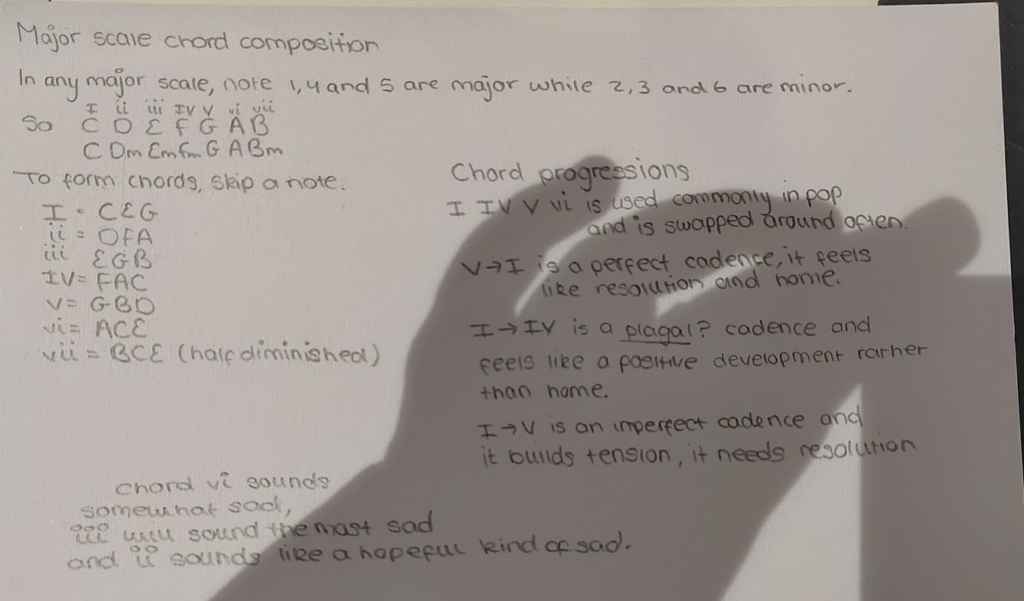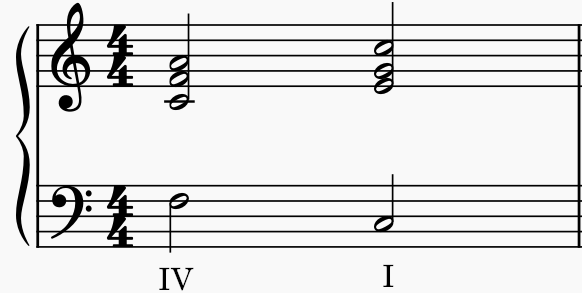Elements of music
Rhythm, melody and harmony are the three most important elements of music.
Rhythm is a pattern applied to any instrument that is capable of putting emphasis on or removing notes from a sequence. Rhythm will be influenced by time signatures and note duration. It’s important to hold a rhythm throughout a song to maintain regularity.
Melody is generally the most memorable part of a song and is based on pitch and rhythm. It’s a sequence of notes composed of normally one scale unless key modulation is introduced.
Harmony is any time two or more notes that don’t clash are played together to create a pleasing sound. It is essentially building chords from notes in the same key.
Songwriters vs Composers
A composition is any artistic idea brought together to form one product. To compose something is to create something. In technicality, a composer would develop a song while a songwriter would also write lyrics.
Basic Theory
The notes I took from this lesson are below.

The circle of fifths is composed of two main sections, the inner and outer ring, and is divided into 12 further sections. Everything on the outside ring is a major key while everything on the inner ring is a minor key. The inner and outer keys share the same notes, so the overall key of a piece is determined by which notes in the scale are built upon and the general mood that this creates. For example, C major and A minor share the same notes but C revolves around the structure of C,D,E,F,G,A,B and C while A minor focuses on A,B,C,D,E,F,G and A. The C major scale will sound bright and happy while A minor will sound gloomy.
The structure of the circle of fifths follows a pattern of continuing using the 5th note in the cycle. Starting at C, the next scale will be G as the notes building to G are C,D,E,F and G, the fifth. This pattern occurs in a clockwise cycle.
The amount of flat or sharp notes in a scale are determined by how far away they are from C. Moving clockwise from C, the number of sharps increases up to 6 sharps. Moving anticlockwise from C, the number of flats increases. To find which notes in a scale are flat or sharp, use ‘Father Child Goes And Ends Battle’ for sharps. This indicates the order of which notes each scale will have sharp, with G having one sharp (F#), D having two (F#, C#) and so on. For flat notes, use ‘Battle Ends And Down Goes Child’s Father’, using the same strategy as you do identifying sharp notes.
Using this, it’s easier to identify what a major scales’ relative minor would be by finding its sixth note or counting down three semitones as every sharp note can be taken into consideration.
Pentatonic scales consist of 5 notes of any scale that cannot clash at all. They’re useful for improvisation and developing interesting melodic ideas without having to worry about notes clashing with others in layered recordings or alongside a chord sequence.

To build and correct my notes on cadences, I did some research using the Phrases and Cadences lesson on musictheory.net and watching a video before this to develop a basic understanding.
So far, I understand that there are two types of finished cadences where the phrase sounds resolved. Both end on chord 1, but a plagal cadence starts at chord 4 and a perfect cadence starts on chord 5.
This is what a perfect cadence looks like in C major:

This is what a plagal cadence looks like in C major:

Unfinished cadences never end on chord 1 and don’t sound resolved. An imperfect cadence ends on 5 but could start on chord 1,2 or 4. An interrupted cadence usually goes from chord 5 to 6, this is used to build tension.
This is what an imperfect cadence looks like in C major, going from chord 4 to 5:

This is what an interrupted cadence looks like in C major:

Knowing about cadences can allow a composition to have phrases with specific sounds. For example, most songs will have some kind of resolution at the end and this could be due to the use of a plagal or perfect cadence.